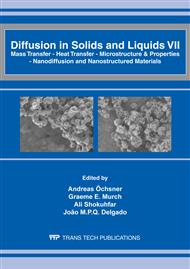p.662
p.668
p.674
p.682
p.690
p.696
p.702
p.708
p.713
Characterising the Differences between the Adsorption and Desorption Processes in a Desiccant Layer by Detailed Numerical Modelling
Abstract:
In this paper, the performance of a channel element of a hygroscopic matrix is evaluated by detailed numerical modeling. The adopted physical model takes into account the gas-side and solid-side resistances to heat and mass transfer, as well as the simultaneous heat and mass transfer occurring simultaneously with the water adsorption/desorption process in the desiccant porous channel wall domain. The desiccant medium is silica gel RD, the equilibrium being characterized by sorption isotherms. Appropriate convective transfer coefficients are taken into account for the calculation of the heat and mass transfer phenomena between the airflow and the channel wall. The response of the channel element to a step change in the airflow states is simulated, the results enabling the investigation of some differences between the adsorption and desorption processes.
Info:
Periodical:
Pages:
690-695
Citation:
Online since:
April 2012
Authors:
Price:
Сopyright:
© 2012 Trans Tech Publications Ltd. All Rights Reserved
Share:
Citation:


